- Page 1:
THE INTERNATIONAL PLATO SOCIETY UNI
- Page 5 and 6:
MONDAY, 15 TH JULY, 2013 3 Eros and
- Page 7:
Monday 15 th July, 2013
- Page 11 and 12:
Eros and Life-Values in Plato's Sym
- Page 13 and 14:
Stephen Halliwell proposition that
- Page 15 and 16:
Stephen Halliwell principle of a un
- Page 17:
The Ethics of Eros: Eudaimonism and
- Page 20 and 21:
Yuji Kurihara final clause that sho
- Page 22 and 23:
Yuji Kurihara wonderfully beautiful
- Page 24 and 25:
ABSTRACT Il ruolo e l'importanza de
- Page 26 and 27: Carolina Araujo if everything is en
- Page 28 and 29: Carolina Araujo changing objects du
- Page 30 and 31: Carolina Araujo Reeve, C. D. C. A s
- Page 32 and 33: David T. Runia transported to the i
- Page 34 and 35: David T. Runia given for why Plato
- Page 37: Method, Knowledge and Identity Chai
- Page 40 and 41: Lesley Brown ἀδελφοῦ ἢ
- Page 42 and 43: Lesley Brown “reconnaître”,
- Page 44 and 45: ABSTRACT The Kind of Knowledge Virt
- Page 46 and 47: Annie Larrivée the Alcibiades, amo
- Page 48 and 49: Annie Larrivée sense that he will
- Page 50 and 51: Annie Larrivée toward a (irrecover
- Page 52 and 53: Annie Larrivée bonheur comme étan
- Page 54 and 55: Annie Larrivée Avant de clore mon
- Page 56 and 57: Annie Larrivée PLATO [1997] The Sy
- Page 58 and 59: Alexis Pinchard dépasser la mesure
- Page 60 and 61: Alexis Pinchard exemple de nature m
- Page 62 and 63: Alexis Pinchard intelligence capabl
- Page 64 and 65: Alexis Pinchard vivant enfante enco
- Page 66 and 67: Alexis Pinchard foncière ; et, tom
- Page 68 and 69: Alexis Pinchard de sa parole vive,
- Page 70 and 71: Alexis Pinchard Donc, quand les mor
- Page 73 and 74: Stylistic Difference in the Speeche
- Page 75: Harold Tarrant contemplate the poss
- Page 79 and 80: Lettori antichi di Platone: il caso
- Page 81 and 82: Margherita Erbì o parti della trad
- Page 83 and 84: Margherita Erbì se non assoluto in
- Page 85 and 86: Ruby Blondell - Sandra Boehringer b
- Page 87 and 88: Ruby Blondell - Sandra Boehringer I
- Page 89 and 90: Ruby Blondell - Sandra Boehringer L
- Page 91 and 92: Ruby Blondell - Sandra Boehringer i
- Page 93 and 94: Gerard Boter being”, which unites
- Page 95 and 96: 4. εἴπερ τῳ ἄλλῳ ἀ
- Page 97: Plenary session Chair: Mary Margare
- Page 100 and 101: Mario Vegetti Fin qui, secondo Diot
- Page 102 and 103: Mario Vegetti oltreterrena delle id
- Page 104 and 105: Mario Vegetti è di peso (onchos) m
- Page 106 and 107: Mario Vegetti gnoseologica (oltre c
- Page 108 and 109: Mario Vegetti NUCCI (2009): M. NUCC
- Page 111: Plenary session Chair: Giuseppe Cam
- Page 115: The Frame Dialogue: Voices and Them
- Page 118 and 119: Narrazioni e narratori nel Simposio
- Page 120 and 121: Lidia Palumbo l’ascoltatore. Gius
- Page 122 and 123: Lidia Palumbo marcatamente che allo
- Page 124 and 125: Matthew D. Walker happiness in, or
- Page 126 and 127:
Matthew D. Walker has brought him j
- Page 128 and 129:
Matthew D. Walker from fully identi
- Page 130 and 131:
Dino De Sanctis vista la sua straor
- Page 132 and 133:
Dino De Sanctis A differenza di Eup
- Page 134 and 135:
No Invitation Required? A Theme in
- Page 136 and 137:
Giovanni R.F. Ferrari those around
- Page 138 and 139:
Diotima and kuèsis in the Light of
- Page 140 and 141:
Anne Gabriel Wersinger This traditi
- Page 142 and 143:
Anne Gabriel Wersinger 138 “Orphe
- Page 144 and 145:
Anne Gabriel Wersinger Bibl. BERNAB
- Page 147 and 148:
Phaedrus and the sophistic competit
- Page 149 and 150:
Hippias. 13 Noburu Notomi Since Hip
- Page 151 and 152:
speakers represents sophistic antag
- Page 153 and 154:
Eros sans expédient : Banquet, 179
- Page 155 and 156:
Annie Hourcade Sciou L’un des int
- Page 157 and 158:
Eros protrepōn: philosophy and sed
- Page 159 and 160:
Monopoly on seduction Olga Alieva A
- Page 161 and 162:
Olga Alieva of Chiron’s students
- Page 163 and 164:
Olga Alieva “worldly” passion i
- Page 165 and 166:
La natura intermedia di Eros: Pausa
- Page 167 and 168:
Lucia Palpacelli costretto a duplic
- Page 169 and 170:
Lucia Palpacelli la natura duplice
- Page 171 and 172:
Lucia Palpacelli sembra procedere,
- Page 173 and 174:
Philotimia and Philosophia in Plato
- Page 175 and 176:
Jens Kristian Larsen philotimia, wh
- Page 177 and 178:
Jens Kristian Larsen by philotimia,
- Page 179 and 180:
Olivier Renaut suivre dans le domai
- Page 181 and 182:
Olivier Renaut La philosophia et pl
- Page 183 and 184:
Olivier Renaut Il s’agit ni plus
- Page 185:
Eryximachus Chair: David T. Runia
- Page 188 and 189:
Hua-kuei Ho are noteworthy here. Fi
- Page 190 and 191:
Hua-kuei Ho emotions, perceptions a
- Page 192 and 193:
La medicina di Erissimaco: appunti
- Page 194 and 195:
Silvio Marino nemiche tra di loro.
- Page 196 and 197:
Silvio Marino dei fenomeni fisici;
- Page 198 and 199:
The concept of harmony (187 a-e) an
- Page 200 and 201:
Laura Candiotto and wine to prevent
- Page 202 and 203:
Laura Candiotto 26b1-3 Socrates app
- Page 204 and 205:
Laura Candiotto 2009, pp. 275-308.
- Page 206 and 207:
Richard Stalley an appeal to what h
- Page 208 and 209:
Richard Stalley enough: the city mu
- Page 211:
The Realm of the Metaxy Chair: Beat
- Page 214 and 215:
Michel Fattal Dans la seconde parti
- Page 216 and 217:
Michel Fattal est relation. L’amo
- Page 218 and 219:
Michel Fattal Moyen terme dynamique
- Page 220 and 221:
Michel Fattal désirent devenir sav
- Page 222 and 223:
Michel Fattal de la vie, mon cher S
- Page 224 and 225:
Perché tanta morte in un dialogo s
- Page 226 and 227:
Arianna Fermani I due poli “morte
- Page 228 and 229:
Arianna Fermani 2) rappresenta la c
- Page 230 and 231:
La nozione di intermedio nel Sympos
- Page 232 and 233:
Cristina Rossitto 228 Esiste una so
- Page 234 and 235:
Cristina Rossitto perché non è n
- Page 236 and 237:
Cristina Rossitto 232 dèmone, caro
- Page 238 and 239:
Reproduction, Immortality, and the
- Page 240 and 241:
Thomas M. Tuozzo applies more widel
- Page 242 and 243:
Thomas M. Tuozzo Syposium." Dialogu
- Page 244 and 245:
Piera De Piano loro intelligenza: i
- Page 246 and 247:
Piera De Piano animali. Esistono tr
- Page 248 and 249:
Piera De Piano l’immagine più pe
- Page 250 and 251:
ABSTRACT Socrates as a divine inter
- Page 253 and 254:
Why Agathon’s Beauty Matters Fran
- Page 255 and 256:
Francisco J. Gonzalez 5) In defendi
- Page 257 and 258:
Francisco J. Gonzalez the play with
- Page 259 and 260:
Francisco J. Gonzalez the power of
- Page 261 and 262:
Francisco J. Gonzalez next to him (
- Page 263 and 264:
Mario Regali rappresentate nel 411,
- Page 265 and 266:
Mario Regali Socrate giunge a mostr
- Page 267 and 268:
I. Einleitung Die Poetik des Philos
- Page 269 and 270:
2. Agathons Rede Irmgard Männlein-
- Page 271 and 272:
Irmgard Männlein-Robert ‚Poetik
- Page 273 and 274:
Aikaterini Lefka was just a new-bor
- Page 275 and 276:
Aikaterini Lefka Agathon 26 follows
- Page 277 and 278:
Aikaterini Lefka F. Graf, « Apollo
- Page 279 and 280:
Aikaterini Lefka O. Thomson, «Socr
- Page 281 and 282:
I. INTRODUCTION Tragedy and Comedy
- Page 283 and 284:
Nicholas Riegel contrast to both tr
- Page 285 and 286:
Nicholas Riegel even of the second
- Page 287:
Literary Form and Thought in Aristo
- Page 290 and 291:
Premessa Tra Henologia ed Agatholog
- Page 292 and 293:
Claudia Luchetti non concesso che i
- Page 294 and 295:
Claudia Luchetti e3, le parole dell
- Page 296 and 297:
Claudia Luchetti somiglianza che de
- Page 298 and 299:
Premise Between Henology and Agatho
- Page 300 and 301:
Claudia Luchetti If we analyze the
- Page 302 and 303:
Claudia Luchetti (211b1, e4), prese
- Page 304 and 305:
Claudia Luchetti to establish a jus
- Page 306 and 307:
Claudia Luchetti Philosophie. Inter
- Page 308 and 309:
Aristofane e l’ombra di Protagora
- Page 310 and 311:
Michele Corradi quella del grande d
- Page 312 and 313:
Michele Corradi Platone vuol celare
- Page 314 and 315:
Samuel Scolnicov by more noise and
- Page 316 and 317:
Samuel Scolnicov Hoffman, Ernst 194
- Page 318 and 319:
Roslyn Weiss two conjoined wholes a
- Page 320 and 321:
Roslyn Weiss prohibition, and he an
- Page 323:
Plenary session Chair: Verity Harte
- Page 326 and 327:
Thomas Alexander Slezák weil er es
- Page 328 and 329:
Thomas Alexander Slezák (507e6 - 5
- Page 330 and 331:
ABSTRACT Chi è il Socrate del Simp
- Page 333:
Diotima and the Ocean of Beauty Cha
- Page 336 and 337:
Francisco L. Lisi especial, con la
- Page 338 and 339:
Francisco L. Lisi y Bueno. El diál
- Page 340 and 341:
L'océan du beau : les Formes plato
- Page 342 and 343:
Arnaud Macé caractérisation de ce
- Page 344 and 345:
Arnaud Macé Timée (47b5-c4) on ex
- Page 346 and 347:
Arnaud Macé à cette évaluation c
- Page 348 and 349:
ABSTRACT Socrates’ Thea: The Desc
- Page 351:
Eros, Poiesis and Philosophical Wri
- Page 354 and 355:
Philip Krinks III: PAUSANIAS AND PR
- Page 356 and 357:
Philip Krinks the nature, including
- Page 358 and 359:
Philip Krinks methodological focus,
- Page 360 and 361:
Gabriel Danzig forth. The only part
- Page 362 and 363:
Gabriel Danzig was a special target
- Page 364 and 365:
Gabriel Danzig way. While there may
- Page 366 and 367:
Gabriel Danzig not only shows Agath
- Page 368 and 369:
Gabriel Danzig describes the origin
- Page 370 and 371:
Giovanni Casertano sia φιλόσο
- Page 372 and 373:
Giovanni Casertano altre specie di
- Page 374 and 375:
Giovanni Casertano umano nella sua
- Page 377:
The Picture of Socrates Chair: Chri
- Page 380 and 381:
Edward C. Halper eternal (cf. 29d-3
- Page 382 and 383:
Edward C. Halper understands that t
- Page 384 and 385:
Edward C. Halper would be undermine
- Page 386 and 387:
ABSTRACT Platon als Lehrer des Sokr
- Page 388 and 389:
Graciela E. Marcos de Pinotti Sócr
- Page 390 and 391:
Graciela E. Marcos de Pinotti sabid
- Page 392 and 393:
Graciela E. Marcos de Pinotti (1969
- Page 394 and 395:
Federico M. Petrucci di scena dell'
- Page 396 and 397:
Federico M. Petrucci dell'oplita e
- Page 399:
ORGANIZING COMMITTEE Dipartimento d




